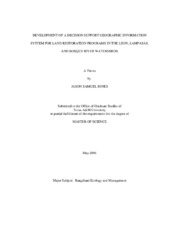| dc.description.abstract | Ashe Juniper encroachment onto privately owned rangelands in Central Texas
has resulted in significant degradation of the ecological condition of these lands, and a
subsequent public concern for the hydrologic function, wildlife habitat, and livestock
production these historically predominant grasslands provide. The result has been an
interest and public investment in land restoration programs such as the removal and
management of brush via landowner cost-share. Implementation of a publicly funded
land restoration program requires the allocation of millions of dollars of public funds on
private lands over large geographic areas that represent hundreds of landowners with
varying property management objectives, tract sizes, ecological conditions, and geologic
characteristics.
This study describes the development, accuracy, and application of a decision
support geographic information system (DSGIS) for land restoration programs
in the Leon, Lampasas, and Bosque River watersheds in the Brazos River basin of
Central Texas. The spatially referenced data layers and associated database within the
DSGIS provide the capability to assemble site specific information including vegetation
cover, endangered species habitat, landowners, ecological sites, elevation and slope, hydrologic characteristics, and political boundaries to support policy and implementation
decisions for Ashe Juniper (Juniperus ashei) brush control and management and goldencheeked
warbler (Dendroica chrysoparia) habitat restoration programs. The goldencheeked
warbler is a federally listed endangered species with a breeding range limited to
the oak-juniper woodlands of Central Texas. The data layers were developed with the
support of ongoing research from the Leon River Restoration Project (LRRP) in Coryell
and Hamilton counties.
One hundred and eighty-eight (188) sub-watersheds were delineated within the
project area and prioritized for implementation of an Ashe Juniper brush control
program and a golden-cheeked warbler habitat restoration program. Costs associated
with the clearing and stacking of Ashe Juniper were estimated for selected subwatersheds
based on projected landowner participation and an analysis of actual costs
from the LRRP. Sub-watersheds were targeted for the implementation of an Ashe
Juniper brush control and golden-cheeked warbler habitat management program in
Bosque, Coryell, Lampasas, Bell, and Burnet counties. Detailed tables were also
developed to document the density and quantity of pertinent layer attributes within each
of the 188 sub-watersheds. | en |


